It’s hard to pick the best places to canyoneer in Utah. The whole southern half of the state is a canyoneering playground, with canyons on every end of the spectrum. There are very simple non-technical hikes through narrow slots, and there are complicated and dangerous multi-day adventures through flowing streams. As always, beware conditions that may lead to flash floods. You can pretty much find canyons near every town in Southern Utah, but which ones are the best for you? In my opinion, and in my experience, these are the best canyoneering locations in Utah for people new to the sport. This isn’t, by any means, a complete list, but this is enough to get you started.
- Zion National Park
- North Wash
- San Rafael Swell
- Moab & Arches National Park
- Saint George Area
The following list isn’t meant to provide beta or directions on the canyons, but should give you a good idea of what’s to come and pique your interest. There are guidebooks and other websites that provide step by step instructions. The ratings I include are based on my experience- depending on precipitation levels and the experience and size of the group, there may be a little bit of variation. Utah is an incredible place, and these canyons are a big reason for that. Be careful, but get out there!

Zion National Park
Zion is arguably the best place for canyoneering in the world. The 229 square miles of its boundaries contain canyon after canyon after canyon, with varying levels of difficulty and water. The park can get very dangerous during rain storms, as flash floods come out of nowhere.
Due to the popularity of the park, and due to the marvel and wonder induced by beautiful pictures, all of the canyons within the park’s boundaries require a permit . The permits, depending on the time of year and popularity of the canyons, can be booked several months in advance and often sell out. Several of the most famous canyons even have a lottery system that doesn’t guarantee you admission until just days before. The National Park Service also does offer some permits the morning of, so consider trying to get into the more popular canyons that way. Zion lives up to the hype, and needs to be at the top of every adventurer’s list. Also- it’s not “Zion’s.”
. The permits, depending on the time of year and popularity of the canyons, can be booked several months in advance and often sell out. Several of the most famous canyons even have a lottery system that doesn’t guarantee you admission until just days before. The National Park Service also does offer some permits the morning of, so consider trying to get into the more popular canyons that way. Zion lives up to the hype, and needs to be at the top of every adventurer’s list. Also- it’s not “Zion’s.”
Here’s some of the best canyoneering in Zion National Park:
The Subway
3B-III
It wouldn’t be a canyoneering list if it didn’t start with the famed Subway. Tourists from all over the world flock to Zion to descend through its concave walls. Lots of different local guiding companies lead groups through on a daily basis, making permits hard to come by. The Subway is one of the few canyons with flowing water, so be wary if going in the springtime, and watch out for potential class C conditions .
.
The canyon isn’t super technical, but does require a few short rappels and some downclimbing. The water is pretty much always cold, so a wetsuit or even drysuit is recommended except during the hottest part of summer. The canyon is rated 3B III, so plan on 6-10 hours to get through it all. Everyone needs to go through The Subway at some point in their life!

Keyhole
3B-II
Keyhole might be the most infamous canyon in southern Utah. In 2015 seven aspiring canyoneers were swept away by a flash flood, and none survived. The canyon is a pretty easy beginner’s canyon, but don’t risk it if there’s any rain in the forecast. The canyon consists of several rappels into water, several swimming sections, and several really deep dark slots. While a wetsuit isn’t absolutely necessary, it’s definitely recommended as the water rarely sees sunshine and stays very cold. It’s a really short canyon, really only 2 hours from car to car, so it is often combined with Pine Creek. Make sure to get permits for both!
Because it’s pretty easy, some people run it at night time in the dark. I’d recommend doing it in the daytime first, but the nighttime option is pretty cool, and fairly unique. There can potentially be small keeper potholes, so be sure to learn and practice safe escape techniques . Keyhole has the best approach of any canyon I’ve been to. You park on the side of the road and then hike 2-300 yards before dropping into the canyon. The mouth spits you out right back onto the road across from your car. This makes for a fantastic early morning canyon before dropping into something bigger.
. Keyhole has the best approach of any canyon I’ve been to. You park on the side of the road and then hike 2-300 yards before dropping into the canyon. The mouth spits you out right back onto the road across from your car. This makes for a fantastic early morning canyon before dropping into something bigger.
Birch Hollow
3A-III
The nice thing about Birch Hollow is that it is outside the boundaries of Zion National Park, and doesn’t require permits (unless you exit through the Narrows). This also means that there is no crowd control (there is a group limit of 12). Get an early start, and it’s very worth it.
Birch Hollow is a great canyon for beginners, with a series of long rappels that will get anyone hooked on the sport. The canyon is dry except during flash floods and early spring, so leave your wetsuit at home. It’s fairly short, and shouldn’t take much more than a half of a day. Because of the 120 meter first rappel, you need to bring a 200ft rope and a pull cord. Save yourself a lot of hiking by using a shuttle car with 4 wheel drive.
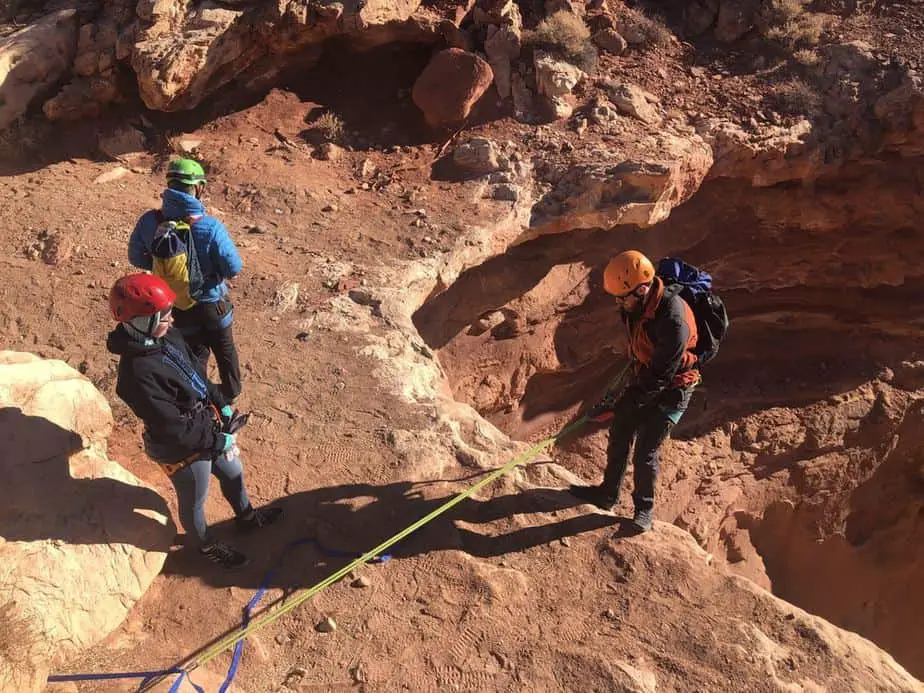
North Wash
The North Wash has more slots than Vegas. Well, maybe not quite, but it’s an even better place to spend a weekend! The North Wash is really remote, even as far as Southern Utah goes. The closest town is Hanksville, about 45 minutes north. Pretty much everything out there is BLM land, so you can camp wherever you want.
The canyons are all sandstone, and are characterized by narrow slots and lots of rappels. The slots in this area are guaranteed to induce a sense of claustrophobia, so count this as your warning! A lot of new canyoneers have cut their teeth in the North Wash Area and fallen in love with the sport.
Here’s some of the best canyoneering in the North Wash:
Leprechaun (East / Middle)
3A-II , 3A-III
The Leprechaun canyons are a great introduction to canyoneering, and especially to this area. The East (aka Leprechaun) and Middle (aka Shimrock) are my favorites. Start with the simpler East Fork, and then do the Middle Fork if you want more of a challenge. There’s some good camping right near the canyon as well, which is convenient and necessary because of the remote nature of the North Wash. You can even drive right up to the mouth of the canyons.
The East Fork is the most beautiful, and has the most rappels. There aren’t bolted anchors, so you need to be comfortable rigging from natural anchors. These are fairly popular canyons though, so you’ll probably find some webbing there- make sure it’s absolutely solid before trusting it! Depending on your downclimbing ability and comfort with exposure, the quantity of rappels may vary. It’s always good to have a good climber in your group who can assist the others once he or she has gone down. Unfortunately, there is some graffiti in the canyon, so go ahead and make your comments about the lowlifes that left it there, and enjoy the rest of the hike out.
The Middle Fork is more difficult than the East Fork, and is a good opportunity to try something more challenging in the North Wash. It’s a little bit longer, and a little bit tighter. Think of it kind of like caving- don’t try it if you think you might get stuck. You will have to hang your backpack from your harness for some of the stemming, and take it off and turn sideways in a lot of the slots. Again, this one is tighter and more difficult than the East Fork, so start with that one.
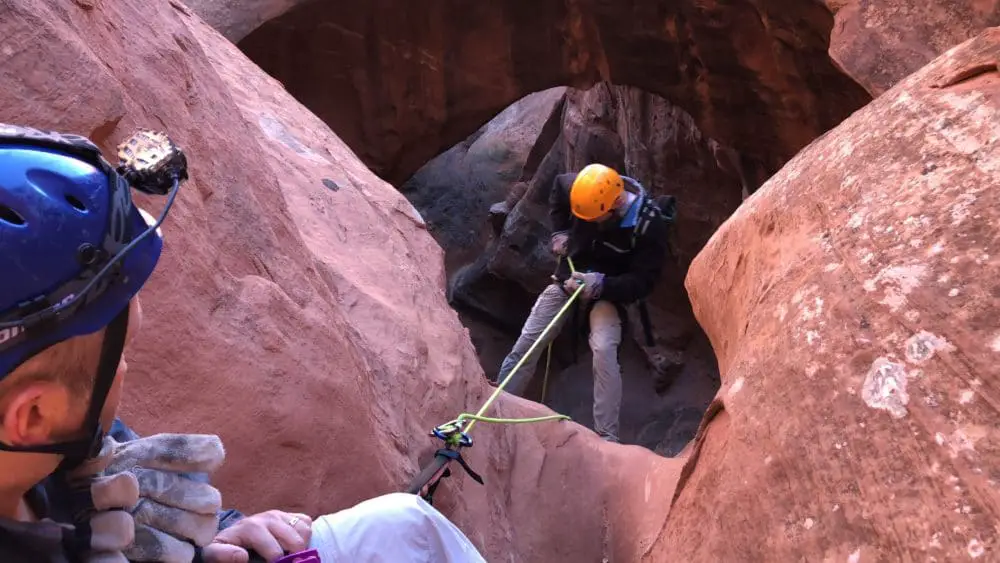
Hogwarts
3A-II
This canyon has a fairly short approach, and packs a lot of fun into its fairly short duration. It’s probably worth a drive down to the North Wash just to run this canyon, but with it only being 2-3 hours long, you can easily hit another one during a Saturday. The highlight of this canyon is the scenic rappel through an arch.
Hogwarts is rated as a dry canyon, but as in all canyons, conditions change rapidly and there could always be some water throughout the slots. The water should be avoidable most of the time, through stemming and bridging techniques. There is one semi-keeper hole , but you can stem or leap over the top of it. There are 4 rappels, with the longest being 90 feet. A 60m rope
, but you can stem or leap over the top of it. There are 4 rappels, with the longest being 90 feet. A 60m rope , accompanied with ample webbing is plenty for this canyon.
, accompanied with ample webbing is plenty for this canyon.
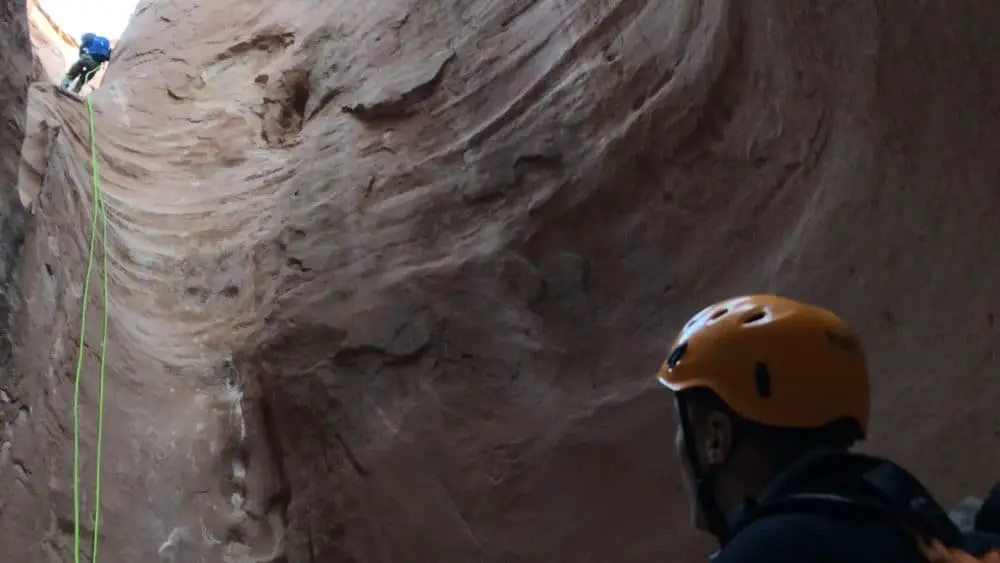
Angel Cove Slot
3A-II
These two canyons are my brother’s favorite in Utah. With the fantastic views of the area, and the huge walls by the Dirty Devil river, it’s a really fun canyon to explore. With little water in the canyon, it’s a great one to do year-round. I like the South fork better, if you have to pick, because it has more rappels. Each fork takes around 3 hours. If you are having a really lucky day, you might get to see some BASE jumpers at the 600ft cliff at the end of the North Slot.
San Rafael Swell
The most well-known area in the swell is Goblin Valley State Park. Made famous in several movies, including the blockbuster Galaxy Quest, the eerie valley of sandstone hoodoos is entirely unique. The whole San Rafael Swell is a labyrinth of canyons and mesas. Everything is sandstone, which makes for really interesting slots and lots and lots of sand. A lot of these canyons require 4×4 to access, and have long approaches on dirt paths.
The San Rafael Swell is one of the closest canyoneering destinations to Salt Lake City, though it’s still about 4 hours away. You can get an early start and do a canyon in a day, but I recommend driving down on a Friday night and camping in the ample dispersed areas nearby. The remoteness makes for incredible stars at night, with only the occasional sound from other campers.
Here’s some of the best canyoneering in the San Rafael Swell:

Ding & Dang
2A-II
Located right outside Goblin Valley State Park, these two canyons make for a really fun afternoon. They blur the line between technical and non-technical because, while no rappelling is required, you definitely need to use handlines in places and know how to partner capture and stem . The first time we went through we brought a 30 foot rope and did use it in a few places, but the second time through a few months later, I forgot it. We made it through with some difficulty, but it’s always best to bring at least a handline.
. The first time we went through we brought a 30 foot rope and did use it in a few places, but the second time through a few months later, I forgot it. We made it through with some difficulty, but it’s always best to bring at least a handline.
The preferred route is to hike up through Ding Canyon, then cross over to the next drainage and come back through Dang Canyon. The reason we run it that way is because Dang has a few large drops that would be difficult to ascend. The highlight of the canyons for me was the latter half of Dang where you have to stem or bridge over some water for several hundred feet. This was great practice, and a good chance for inexperienced members of our group to learn.
Depending on water levels, you will have to get up to waist deep, but shouldn’t have to swim. You do need 4×4 to get there; the dirt road after the parking for Little Wild Horse is really washed out. Little Wild Horse is a great non-technical canyon to take kids through as well.
Baptist Draw
3B-II , 3B-III
This is one of the best technical canyons for beginners in Utah. It’s about a 3.5 hour drive from Salt Lake City, so you can either get an early start in the morning, or drive down the night before and camp. There is dispersed camping all over the place, so you can pretty much set up wherever you want.
The canyon consists of 2-3 easy rappels, some stemming and down climbing, and usually some knee-deep water. There usually isn’t swimming, so wetsuits aren’t recommended. I’ve heard that this canyon gets really nasty in the winter with tons of mud and sludge, so I recommend it in the Spring or Fall. It can be really warm in the summer.
There are two different routes in the canyon, with the option of exploring more of Upper Chute Canyon as well. The short route is around 5 hours, and the long route around 7 hours.
Moab and Arches National Park
Moab is known for its mountain biking, off roading, and multi-pitch climbing; however, there are also some great canyons in the vicinity. Arches National Park, 10 minutes outside of Moab, is not as developed as Zion, and sees less traffic because it’s not really close to anything. Where Zion sees more traffic from out of the state and out of the country because of the St. George and Las Vegas Airports, Arches sees a lot more from locals and people from nearby states. Moab is an awesome place to spend a full week of different adventures.
As far as canyoneering goes, the canyons in Arches National Park are a little bit different from the slots of Zion. They are generally a lot more open, and have less water and keeper holes . Watch out for snow in the winter, and hot and dry temperatures in the summer.
. Watch out for snow in the winter, and hot and dry temperatures in the summer.
Here’s some of the best canyoneering in Moab & Arches National Park:

Elephant Butte
3A-III
Hold your jokes until the end please. Or at least until you start your hike. Sometimes we’re all immature. Elephant Butte is a really cool ‘canyon,’ because the first half requires an ascent up through lots of different rock formations. The navigation is fairly difficult (it’s not a slot canyon where there’s only one direction to go), but not terrible. There are 2 medium rappels that are both really scenic. The first drops down into a canyon area, and the second is an overhang with about 50 feet of free rappelling.
The first time we did it was in February around President’s Day. We made the false assumption that, being a desert, everything would be dry. We discovered the fallacy in our thinking as soon as we go to the first spot that was shaded by cliffs and saw the snow! This definitely turned our adventure into Type 2 fun. I was thigh-deep in snow trying to carve out steps for the rest of the group as I climbed up one arete to an upper area. Some sections that should have been very simple class 4 climbs turned into partner lifts and then ascending with me as the meat anchor. The final rappel had become an icy waterfall, and we had to break out the emergency blankets for the younger members of the party.
All in all, it was the most memorable canyoneering experience I’ve had to date, and definitely the most ‘fun.’ To put it in perspective, it took us more than 5 hours to complete that day. We came back a few months later in May and completed the whole canyon in just over an hour!
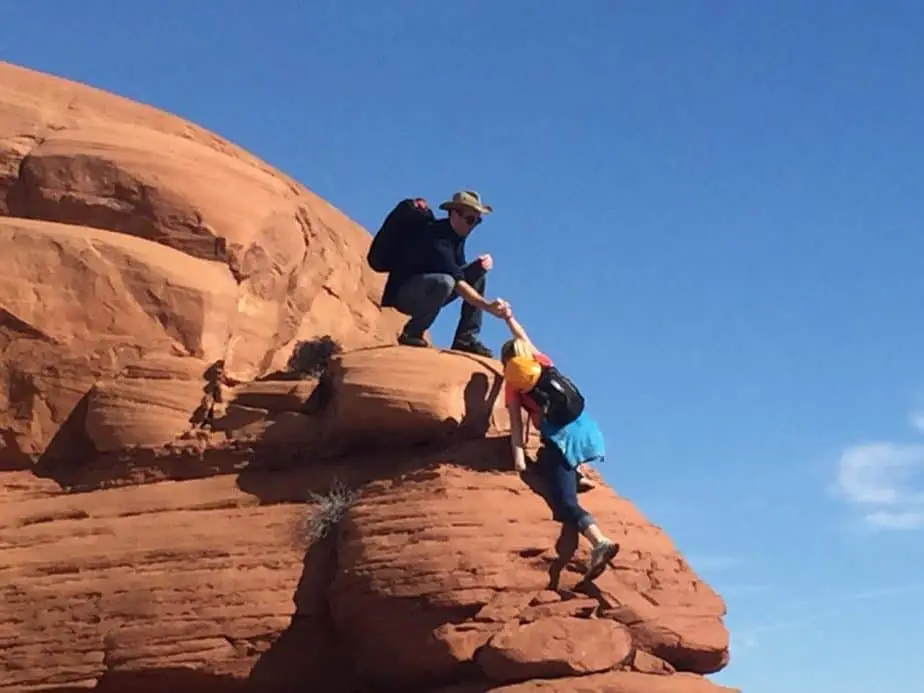
U-Turn Canyon
3A-II
This canyon is right inside of Arches National Park, near the area called “Park Avenue.” As is characteristic with the Arches area, the rock is all sandstone, and the walls are huge. The navigation is difficult, as there aren’t any slots that direct where to go. You need to have a good understanding of the routes with GPS coordinates. The nice thing about the open canyons is you will be able to get GPS signal.
The hike begins with scrambling up a trail to the top of some sandstone cliffs. After hiking along the top of the cliffs and enjoying views of the park, you start with a simple, short rappel (can be done with a handline). The descent continues around a few short drops until you get to a cliff’s edge. This last rappel is an overhanging drop of around 70 feet. Hike out of the cove and back along the trail with all of the tourists at Park Avenue. This is another really short canyon that should take 1-2 hours.
We had to bail the first time we tried U-Turn Canyon. As a part of the same doomed President’s Day trip as Elephant’s Butte, we got stuck in the snow. We did the first rappel, but waited to pull the rope because of how much snow blanketed the ground. My brother and I approached the next area that looked like a rappel, and spent 45 minutes clearing snow looking for the supposed anchors.
Frustrated, we eventually gave up, ascended the rope, and hiked back to the car. Our hands and feet were frozen, and we were bummed out. When I came back in May, we realized that without snow, what we thought was a rappel could easily be hiked down. Sandstone has a lot more grip when it isn’t blanketed in snow and ice!
Saint George Area
Saint George is the biggest city in Southern Utah, and the only one with a real airport. The city is also a fairly short drive from Las Vegas, as well as Salt Lake City. It’s terrible for 3 months during the summer, but that’s why the term ‘snowbird’ exists. The other 9 months of the year are amazing for all outdoor adventures, including biking, climbing, hiking, and, of course, canyoneering.
Here’s some of the best canyoneering in the Saint George Area:

Yankee Doodle Canyon
3B-II
This is one of the closest canyons to the St. George area, located just outside of Leeds. The access road is dirt, but is passable in a regular car. The canyon starts with a short rappel that can be easily bypassed (not sure why you would do that). The first rappel is a good warm up/refresher for those who haven’t been on a rope in a while. Shortly after the first drop, the meat of the canyon starts. It immediately goes into a 100ft rappel into a shallow pool of water (seasonal). The first person has to get wet, but with a guided rappel the rest of the group can avoid the water.
After that long rappel, the slots begin in earnest. The slot section is usually full of water, with several swims required, as well as a few more short rappels. A handline is useful to navigate some of the more difficult downclimbs as well, as is knowledge of some of the partner capture techniques.
The water gets pretty disgusting, and turns into some nice canyon stew. The smell is powerful if it hasn’t rained in a while! A wetsuit is necessary for the winter, but for Fall, Spring, and Summer it isn’t required. The exit is a little bit difficult to find, and requires some class 4 scrambling, so make sure you pay attention and rope up if needed.
Boltergeist
3A-I
This canyon is also a good beginner-friendly canyon right outside of Leeds, near Saint George. This one doesn’t have as much water as Yankee Doodle, and is shorter in duration. Boltergeist is usually dry, with a few avoidable potholes. You don’t need high clearance to access the canyon, which makes it a nice quick canyon for people visiting Saint George.
There are 3 rappels, with the max being about 100 feet high. The last rappel has an overhang, which is always fun. The canyon only takes 1-3 hours, so you can combine it in a day with Yankee Doodle. It’s nice and short, and gives a good taste of what canyoneering has to offer.
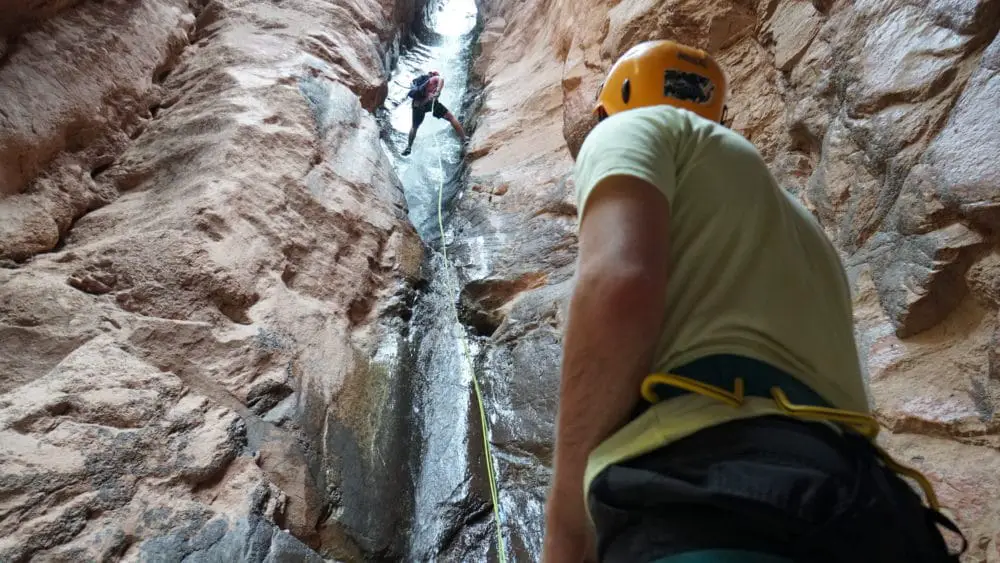
Benson Creek Canyon
3C-II
This is a pretty popular family-friendly hike to a waterfall. Or, if family-friendly hikes are boring to you, rappel down it! Benson Creek is located just down the road from Brian Head Resort near Cedar City. The hike in is a nice trail right up until it splits off and shoots up the mountain. We were unable to find a nice trail to the top, so we had to scramble up some class 3 and 4 terrain to get up. The action starts almost immediately after you come to the top of the ridge.
The first rappel is a 75-foot drop down a waterfall. The creek is flowing year round, though it’s usually not much more than a trickle. The canyon has really steep, high walls, and is really impressive. The first rappel leads right into the next rappel, and then there’s a short walk to the final rappel that drops out of the canyon. There are usually hikers at the base of the last rappel, and it’s always nice to have a crowd to cheer you on! This is another short canyon, car to car in 3 hours.
See Also:
Is Canyoning Dangerous? Canyoneering Safety Tips

